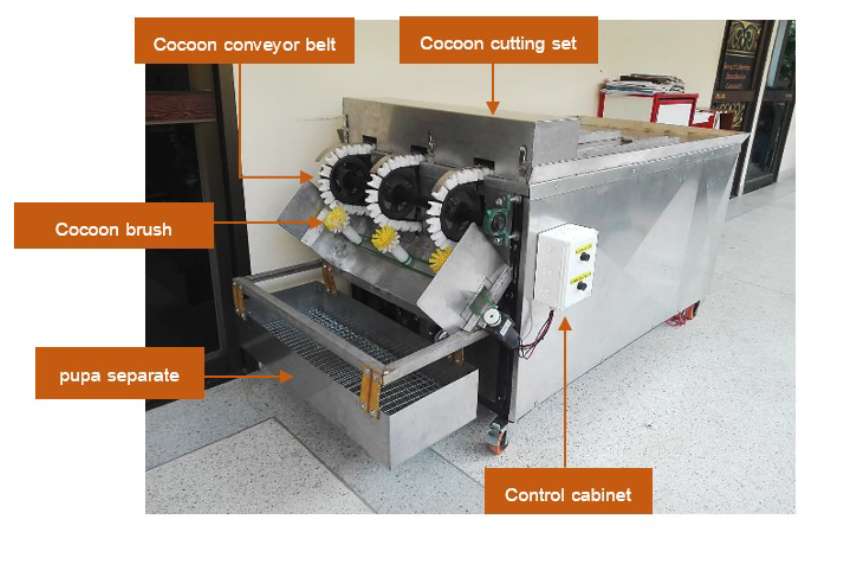Development of an Eri Cocoon Cutting and Separating Machine
doi: 10.14456/mijet.2020.13
Keywords:
Cutting, separating, Eri, Cocoon, PupaAbstract
The fibers of eri silk are light, fluffy, sweat-absorbing, and have a unique characteristic. The process of producing eri fiber consists of cutting the cocoon to remove the pupa from the cocoon, degumming and carding. In general, to separate the pupa from the cocoon, farmers use scissors to cut the cocoon by cutting one end of the cocoon. From surveying, it found that the average cutting rate is only 1.5 kilograms per hour per person. Other than that, there is a shortage of labor. For these reasons, agriculture is unable to produce enough eri silk to meet market demand. The purpose of this research was to develop the eri cocoon cutting and separating machine to cut cocoons and to separate the pupa from the cut eri cocoon. The size of the eri cocoon cutting machine is 0.85 meters in width, 1.50 meters in length and 0.80 meters in height. It consists of three conveyor belts that are made into a groove for placing cocoons by hand. The cutter set uses a blade that can adjust the degree of cutting. The separation of the pupa from the cocoon uses vibrations driven by a slider-crank mechanism. From the experiment results to find the most suitable conditions of the machine, it was found that if the blade was tilted at an angle of 50 degrees to the horizontal level and the conveyor speed was set at 2.2 meters per minute, the machine gave the best results. When the speed of the pupa separator is 250 rpm, the cutting machine gave the average cutting rate of 6.424 kilograms per hour and the percentage of pupa separated from the cocoon was 100 significantly. From this operating result, it can be concluded that an eri cocoon cutting and pupa separating machine developed from this research can increase the cutting and separating rate of eri cocoon and tend to be used in the group of eri silk farmers.
References
Sivilai, S., Sangtamat, T., Saksiriret, W., and Waikakul, Y., (2004), Current Advances and Development in Wild Silkmoths and Tropical Bombyx Silks,” October 11-14, 2004, Khon Kaen, Thailand, P63,
Rajkhowa R, Kaur J, Wang X, Batchelor W. (2015), Intrinsic tensile properties of cocoon silk fibres can be estimated by removing flaws through repeated tensile tests. J R Soc Interface. 2015 Jun 6;12(107):20150177. doi: 10.1098/rsif.2015.0177. PMID: 25948613; PMCID: PMC4590502.
Attathom, T., (2016), Erie silk raising: alternative careers. Research and Development Coordination Office. Department of Entomology. Faculty of Agriculture at Kamphaeng Saen, Kasetsart University (Thailand). (in Thai).
National Bureau of Agricultural Commodity and Food Standards, Ministry of Agriculture and Cooperatives. Good practice for cocoon production. (2012). Thai Agricultural Standards. Thailand, 8201-2555. (in Thai).
Photchanaprasert, N., Patoomnakul, A., and Suchato, R.. (2017). Guidelines to promote the industrial potential of Eri farmers: Final research report. Supported by the Thailand Research Fund (TRF). Bangkok (Thailand). (in Thai).
Koç, B., Eren, I., and Kaymak, E. F., (2008), Modelling bulk density porosity and shrinkage of quince during drying: The effect of drying method, Journal of Food Engineering, 85(3) : 340-349.
Shigley, J. E. and Mischke, C.R. Mechanical Engineering Design. 5th Edition. McGraw- Hill Book Company, USA. 1989.
Lungkapin, J.. (2015), Theory of agricultural machinery. Triple Educational Publishing Company Limited, Bangkok(Thailand). (in Thai).
Krutz, G., Thomson, L., and Claar, P. (1994), Design of Agricultural Machinery. John Wiley and Sons. New York Chicheter Brisbne, Toronto, Singapore.
Kakahy, A, N, N., Ahmad, D., M., D, Akhir, Sulaiman, S., and Ishak. A., (2014), Effects of Rotary Mower Blade Cutting Angles on the Pulverization of Sweet Potato Vine, Agric. Agric. Sci. Procedia, 2 : 95–101,
Huang, M-S., Chen, K-Y. and Fung, R-F. (2010), Comparison between mathematical modeling and experimental identification of a spatial slider–crank mechanism, Applied Mathematical Modelling : 2059–2073.
Montgomery, D.C. (2013), Design and Analysis of Experiment. 8th ed., John Wiley & Sons, inc.,
Umair, J., Robina, F, Farrukh, S. and Zakir, K., (2018), Optimization of HNO3 leaching of copper from old AMD Athlon processors using response surface methodology. Journal of Environmental Management, 211(1) : 22-27.

Downloads
Published
How to Cite
Issue
Section
License
Copyright (c) 2020 Mahasarakham International Journal of Engineering Technology

This work is licensed under a Creative Commons Attribution-NonCommercial-NoDerivatives 4.0 International License.




